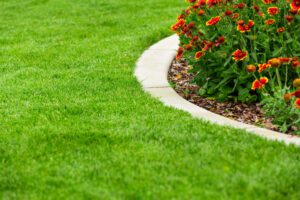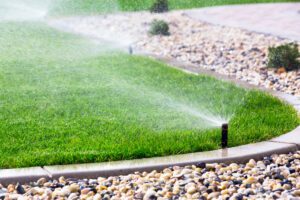We know your new concrete border will make you happy. Decorative curbs make your yard look beautiful and save you hours of time that you would have spent trimming and edging. Use the following quick facts and instructions to care for and maintain the look of your curb.

Water and your new concrete edging
There’s no need to spray or mist your new concrete with water. Cover it with plastic if it starts to rain in the first eight hours after the curb is put in. When caring for your landscape curbs, it’s important to take it away the next day.
During the first 72 hours, sprinklers shouldn’t hit the curbing directly. After 24 hours, a mist won’t damage your new edging, but a sprinkler within a couple of feet could produce pits.

Letting your new edging cure properly
Your new edge is made of concrete. Most concrete is fully cured after 28 days. During the first two weeks after the curbing is installed, be extra careful not to damage it. Care should be taken when using rakes, shovels, and other gardening tools.
For at least the first 72 hours, keep kids, adults, pets, and vandals away from your curbing. Even though it feels hard to the touch, it can still be hurt in the first 24 hours. Sod, sprinklers, and other landscaping work should wait at least 72 hours after installation before being performed around the curb.
Keep lawnmowers away from your curbing for the first week. It’s not likely that the wheels will damage the edge, but the metal corners of your lawn mower might get scratched or broken while the paint is drying.
Cleaning and caring for your landscape curbs
Different environmental factors can cause efflorescence to show up on concrete curbing. Water and salts combine to make this white powder residue. When standing water on a curb evaporates, a salty substance is sometimes left behind. It can come up from the ground, from rain, or from sprinklers. How strong it is depends on how much water there is and how hard it is. If you water your plants often, efflorescence may show up more often. If you need to clean efflorescence, mix equal parts vinegar and water and brush it off. Depending on the amount of residue on your curb, this may require multiple treatments to remove, but the efflorescence should go away in the end.
Some fertilizers and chemicals will stain the curbing just like they would any other concrete. Instruct anyone applying fertilizer not to spray fertilizer on the curbing. Iron, whether in granules or as a spray, will have the greatest negative effect on curbing. If fertilizer has contacted your concrete curb, give it a generous rinse with a hose immediately after fertilization is complete.
Sealing your concrete curbing
If your concrete curb has been painted, it’s likely that it has also been sealed. UV light and rays will eventually cause color to fade. Every year to two years, resealing is recommended. Not up to the task? Let us know and we can come back and reseal for a small fee. Just give us a call, and we’ll be happy to come back and help you keep your curbing looking as good as new.
Looking at installing curb edging? Be sure to contact our crew for a consult! These quick tips for caring for your curb will be beneficial afterward!
